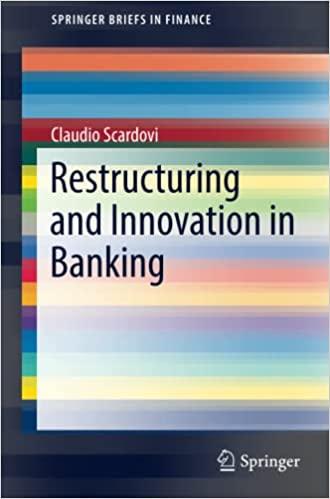Question
1. Suppose Joe has the choice of two investments. He can invest in a bond, which in 10 years (not accounting for inflation), will have
1. Suppose Joe has the choice of two investments. He can invest in a bond, which in 10 years (not accounting for inflation), will have a 50% probability of a 50% return and a 50% probability of a 40% return. On the other hand, he could invest in a mutual fund that in 10 years would have a 50% chance of returning 100% and a 50% chance of returning -20%. If he chose the latter investment, would he be considered Risk Neutral, Risk Averse, or Risk Loving?
2. Now, Dr. Pennyworth has a chance to purchase one of two professional cricket clubs, the Miami Manatees or the Jacksonville Gemini. At the beginning of last year, the Manatees were purchased for $100 million, provided $10 million in profits, and are currently on sale for $110 million. On the other hand, the Gemini started the year purchased at $80 million, provided $30 million in profits, and are currently on sale for $140 million. Calculate the rate of return for the owners of each team last year. Which team would you suggest that Dr. Pennyworth purchase today?
3. For the above problem, you project that the most optimistic profits for the Manatees this year is $35 million, while the most pessimistic projection is $5 million. Your projections for the Gemini are $32 million and $7 million, respectively. Based only on the range, which do you think is the riskier investment? Which one would you choose?
4. Imagine there are two free agent outfielders available. They both cost the same price, but you only have the money to sign one. Assume home runs alone are a proxy for performance. Suppose Player 1 has a 20% chance of hitting 20 home runs and a 20% chance of hitting 25 home runs, a 25% chance of hitting 30 home runs, a 20% chance of hitting 35 home runs, and a 15% chance of hitting 40 home runs. Player 2 has a 10% chance of hitting 10 home runs and a 10% chance of hitting 15 home runs, a 10% chance of hitting 25 home runs, a 30% chance of hitting 30 home runs, a 30% chance of hitting 35 home runs, and a 10% chance of hitting 50 home runs.
a. Which player has the highest expected return?
b. Which player would represent the riskier investment?
c. Which player would you choose?
d. What does this say about your risk preferences?
5. If there is a high chance of a negative return, why would a general manager invest in a very risky player? How might this conflict with the goals of the team as a whole?
6. Assume Mike Trout has the following distribution of outcomes for 2012. If he gets hurt, he will need some time to recover even while in the lineup, so he cannot produce at his highest level even if he comes back from an injury. If he does not get hurt, then he is certain to either Produce A, B or C, with A > B > C.
| Outcome | Probability | Return/Production |
| Gets Hurt, Misses Whole Season | 10% | 0 wins |
| Gets Hurt, Misses 1/2 season, Produces B | 20% | 1.5 wins |
| Gets Hurt, Misses 1/2 season, Produces C | 10% | 0.75 wins |
| Gets Hurt, Misses 1/4 season, Produces B | 10% | 3 wins |
| Gets Hurt, Misses 1/4 season, Produces C | 10% | 1.5 wins |
| No Injury, Produces A | 20% | 10 wins |
| No Injury, Produces B | 10% | 6 wins |
| No Injury, Produces C | 10% | 3 wins |
Using the above information, calculate Mike Trouts expected production for next year. What is his range of possible performances? What about his standard deviation? Using the standard deviation, calculate the interval within which Trouts performance should fall 95% of the time. Does anything seem strange about this calculation?
7. Suppose you could make an investment. With Investment 1, there is a 20% chance of making $10, a 15% chance of making $20, a 20% chance of making $25, a 20% chance of making $30, a 20% chance of making $40, and a 5% chance of making $100. For Investment 2, there is a 25% chance of making $1,000, a 50% chance of making $2,000, and a 25% chance of making $7,500. Use the coefficient of variation to evaluate the risk involved in these two investments. How does this result differ from using the range? How does it differ from comparing the two using only the standard deviation? Why is this important?
8. Based on the following table of yearly revenues, do you think the two teams are compliments or substitutes? Why?
| Year | Manatees | Gemini |
| 2005 | $10 | $10 |
| 2006 | $5 | $15 |
| 2006 | $15 | $20 |
| 2008 | $25 | $35 |
| 2009 | $12 | $12 |
| 2010 | $12 | $15 |
| 2011 | $20 | $25 |
Step by Step Solution
There are 3 Steps involved in it
Step: 1

Get Instant Access to Expert-Tailored Solutions
See step-by-step solutions with expert insights and AI powered tools for academic success
Step: 2

Step: 3

Ace Your Homework with AI
Get the answers you need in no time with our AI-driven, step-by-step assistance
Get Started


